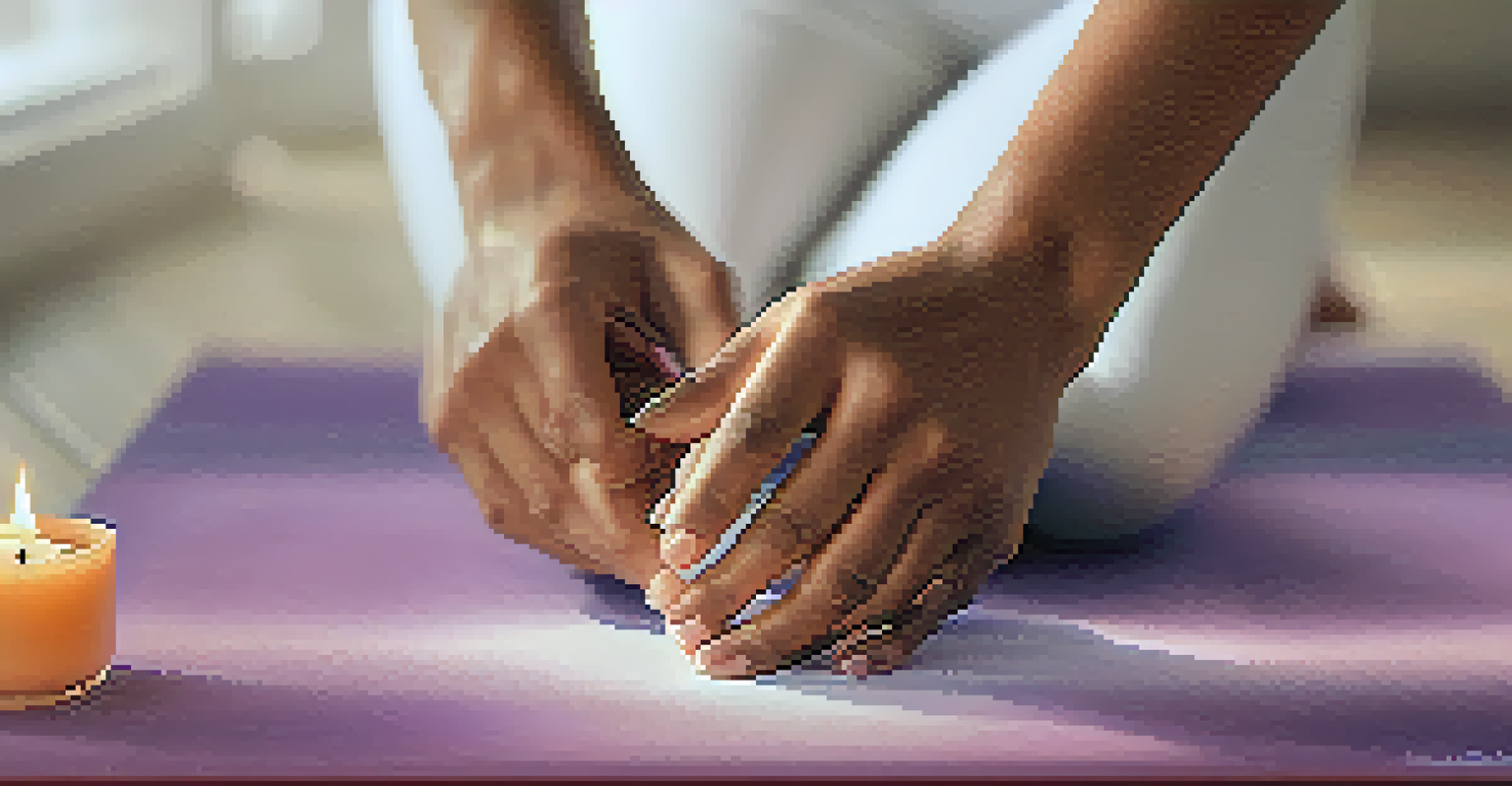How to Incorporate Essential Oils into Your Yoga Routine

Why Use Essential Oils in Your Yoga Practice?
Incorporating essential oils into your yoga routine can elevate your experience in profound ways. They can enhance relaxation, promote focus, and even invigorate your spirit. Imagine the calming scent of lavender wafting through the air as you settle into a peaceful pose, creating an atmosphere of tranquility.
Essential oils are the most powerful tools for transformation and relaxation in yoga practice.
Essential oils are known for their therapeutic properties, which can help to deepen your practice. For example, eucalyptus oil can help clear your mind and improve your breathing, making it easier to connect with your body during meditation. This synergy between scent and movement can lead to a more fulfilling practice.
Moreover, using essential oils can personalize your yoga experience. Whether you need energizing citrus scents for a morning flow or calming chamomile for a restorative session, you can tailor the aromas to fit your mood and needs. This adaptability makes essential oils a versatile addition to your routine.
Choosing the Right Essential Oils for Yoga
When selecting essential oils for your yoga practice, consider your specific goals. Some oils are uplifting, like peppermint or lemon, while others, such as sandalwood or bergamot, are more grounding. Think of these scents as your yoga companions, each contributing to your journey in its unique way.

It's also essential to choose high-quality oils. Look for pure, therapeutic-grade essential oils, as synthetic fragrances can detract from the benefits. Brands that provide clear sourcing and testing information can help ensure you’re using the best options available.
Enhance Your Yoga with Scents
Incorporating essential oils can deepen relaxation, focus, and enjoyment during your yoga practice.
Lastly, consider your personal preferences. Aromas are subjective, and what invigorates one person may overwhelm another. Experiment with different oils to discover which fragrances resonate with you, making your yoga sessions more enjoyable and effective.
Methods to Use Essential Oils During Yoga
There are several ways to incorporate essential oils into your yoga practice. One popular method is to diffuse the oils in the room before you start. This creates a pleasant environment that welcomes you and helps set the mood for your session, much like the gentle lighting in a yoga studio.
The use of aromatherapy in yoga can elevate your practice from a physical exercise to a holistic experience.
Another effective method is to create a personal oil blend for topical application. Dilute essential oils with a carrier oil, like coconut or jojoba, and apply it to pulse points or areas that may need extra support during your practice. This not only enhances the aromatic experience but also allows your body to absorb their benefits directly.
Finally, consider using essential oils in your breathwork. A few drops on your palms, followed by a deep inhale, can help center your mind and body. This practice can also deepen your connection to your breath, which is a fundamental aspect of yoga.
Creating a Calming Environment with Essential Oils
A calming environment is essential for a successful yoga practice, and essential oils can play a pivotal role in achieving this. By diffusing soothing scents like lavender or chamomile, you can create an atmosphere that promotes relaxation and focus. This is particularly beneficial if you practice at home, where distractions can easily pull you away from your flow.
You might also consider incorporating essential oils into your yoga props. For instance, applying a few drops of oil to your yoga mat before practice can envelop you in your favorite scent as you move. This sensory experience can help ground you and enhance your overall practice.
Choose Oils to Match Your Goals
Selecting the right essential oils based on your specific yoga style and personal preferences can enhance your overall experience.
Additionally, pairing your chosen oils with soft lighting and calming music can further elevate your environment. Think of your yoga space as a sanctuary where each element complements the others, creating a harmonious atmosphere that encourages deep reflection and connection.
Mindfulness and Intentions with Essential Oils
Incorporating essential oils into your yoga practice can also enhance your mindfulness and intention-setting. Before you begin, take a moment to select an oil that resonates with your goals for the session. For example, if you seek clarity, you might choose lemon for its refreshing properties.
As you apply the oil or inhale its scent, visualize your intention for the practice. This can help solidify the connection between your mind, body, and spirit, allowing you to focus on what you wish to achieve. This intentionality can transform your yoga routine into a more meaningful experience.
Furthermore, this practice of mindfulness can extend beyond your yoga mat. By connecting your intentions with specific scents, you may find it easier to recall that sense of purpose throughout your day, using the aroma as a gentle reminder of your goals.
Essential Oils for Different Yoga Styles
Different yoga styles can benefit from various essential oils that complement their unique energies. For instance, if you're practicing a vigorous style like Vinyasa, invigorating oils like peppermint or ginger can provide an extra boost of energy and stamina. These scents can help you maintain focus and enthusiasm as you transition between poses.
On the other hand, restorative practices like Yin or Hatha may benefit from calming scents such as lavender or frankincense. These oils can help you relax into each pose, promoting deeper stretches and fostering a sense of peace during your practice. Think of these oils as your supportive allies, helping you achieve the balance needed for each style.
Practice Safety with Essential Oils
Always dilute essential oils and perform patch tests to ensure a safe and enjoyable practice.
Ultimately, your choice of oil should align with the energy you wish to cultivate during your practice. Experimenting with different oils for various styles can deepen your understanding of how scent influences your yoga experience.
Safety Tips for Using Essential Oils in Yoga
While essential oils offer numerous benefits, it's essential to use them safely in your yoga practice. Always dilute oils with a carrier oil before applying them to your skin, as undiluted oils can cause irritation. This simple step can help you enjoy the therapeutic effects without discomfort.
It's also a good idea to perform a patch test before using a new oil, especially if you have sensitive skin. By applying a small amount to a discreet area, you can ensure that the oil won't cause any adverse reactions during your practice.

Additionally, be mindful of any allergies or sensitivities you may have. Some oils, like eucalyptus or tea tree, can be potent and may not be suitable for everyone. Listening to your body and adjusting your practices accordingly will ensure a safe and enjoyable experience.